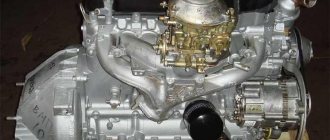Technical characteristics of the car GAZ 32214 2.4 (1996)
Technical characteristics of GAZ 32214 2.4
The ambulance version of the Gazelle 32214 is intended for linear ambulance stations and can transport no more than three patients and two workers. Mandatory equipment consists of a walkie-talkie, additional lamps above the rear and sliding side doors, a flashing light, exhaust ventilation, a stretcher, a first aid kit, transport tires, and a water tank. The compartments for patients and medical staff are isolated from the cabin by a metal partition with a built-in sliding window.
The automobile catalog contains a description, technical characteristics and photographs of the GAZ 32214 2.4 car.
Sale of used GAZ 3221 cars
Reviews from GAZ car owners
- 02.01.2010
Terentyev Andrey Gelievich
Author's rating
Objectivity
I bought this car solely because of the diesel engine. And you were right! On the highway - 6.0l, in the city in the summer 7.2-7.5l, in the winter 8.5l. It starts perfectly in cold weather if the battery is fully charged. I think this car is the best. Compared to the previous one, 2402 is quiet and warm. Carried out a number of welding and painting works. Because I like everything to be like new. There were problems with the documentation, as well as with some spare parts that should have been replaced during maintenance. Those. I was famously promoted out of ignorance. In everything else, I’m very pleased.
more details
- 09.02.2010
Sergey2
Author's rating
Objectivity
I drove a Volga from 2003 to 2007. Overall I'm happy with the car. There were breakdowns, but, unlike foreign cars, they could be fixed on their own. The power steering, which was not installed on all Volgas, helped a lot. The weak point is the rotten body; no amount of anti-corrosion can save it in Moscow conditions, which is why I had to part with the car. Now I drive a Daewoo Nexia, and I remember the Volga with warm feelings.
more details
- 02.08.2007
vladimir
Author's rating
Objectivity
Everything is not bad, except for the joints of the Volga with the Chrysler engine
more details
www.autonet.ru
Notes
- How to apply for a pass for freight transport (undefined)
. Official website of the Moscow Mayor (2020). - (unspecified)
are starting in the GAZ dealer network (inaccessible link). gazgroup.ru (February 25, 2010). Retrieved March 1, 2010. Archived March 23, 2011. - Start of sales of "GAZelle-Business" (unspecified)
(inaccessible link). gazgroup.ru (February 4, 2010). Access date: February 4, 2010. Archived August 20, 2011. - BFM.ru.
Gorky Automobile Plant o (Russian).
BFM.ru - business portal
. Date of access: April 8, 2022. - GAZ: modernization of production (Russian). kp.ru
(December 4, 2015). Date of access: April 8, 2022. - Gazelle Next Archived copy from February 7, 2013 on the Wayback Machine.
- The history of the appearance of the GAZelle and its predecessors (from the GAZ-AA and GAZ-56 to the GAZ-3302) (unspecified)
. www.gruzovikpress.ru. Date accessed: March 9, 2022. - "Gazelle": car and name (undefined)
. www.gruzovikpress.ru. Date accessed: March 9, 2022. - How Deripaska created a new philosophy of industrial production at GAZ (Russian). www.mk.ru.
_ Date of access: April 8, 2022. - "GAZelle-Business CNG" with methane launched into series
- GAZelle is recognized as the most expensive automobile brand in Russia (undefined)
.
www.autostat.ru
. Date of access: April 8, 2022. - "Gazelle": 25 years on the assembly line (Russian). 5th wheel
(July 19, 2019). Date of access: April 8, 2022. - 25 years of GAZelle. The car that took out young Russian capitalism, TASS
. Retrieved April 8, 2022. - Gazelle Economy (unspecified)
(inaccessible link). gazgroup.ru (2009). Access date: February 2, 2010. Archived August 10, 2009. - A complete list of differences between the Gazelle Economy configuration and the base car (unspecified)
. gazgroup.ru (2009). Access date: February 2, 2010. Archived February 20, 2012. - Buses “Ruta 25 Nova” (Russian) appeared on domestic roads. "Autocenter" (October 21, 2014). Access date: September 11, 2016.
Gazelle:
- Media files on Wikimedia Commons
Technical characteristics of the car GAZ 32214 2.9 (1996)
Technical characteristics of GAZ 32214 2.9
The ambulance version of the Gazelle 32214 is intended for linear ambulance stations and can transport no more than three patients and two workers. Mandatory equipment consists of a walkie-talkie, additional lamps above the rear and sliding side doors, a flashing light, exhaust ventilation, a stretcher, a first aid kit, transport tires, and a water tank. The compartments for patients and medical staff are isolated from the cabin by a metal partition with a built-in sliding window.
The automobile catalog contains a description, technical characteristics and photographs of the GAZ 32214 2.9 car.
Sale of used GAZ 3221 cars
Reviews from GAZ car owners
- 02.01.2010
Terentyev Andrey Gelievich
Author's rating
Objectivity
I bought this car solely because of the diesel engine. And you were right! On the highway - 6.0l, in the city in the summer 7.2-7.5l, in the winter 8.5l. It starts perfectly in cold weather if the battery is fully charged. I think this car is the best. Compared to the previous one, 2402 is quiet and warm. Carried out a number of welding and painting works. Because I like everything to be like new. There were problems with the documentation, as well as with some spare parts that should have been replaced during maintenance. Those. I was famously promoted out of ignorance. In everything else, I’m very pleased.
more details
- 09.02.2010
Sergey2
Author's rating
Objectivity
I drove a Volga from 2003 to 2007. Overall I'm happy with the car. There were breakdowns, but, unlike foreign cars, they could be fixed on their own. The power steering, which was not installed on all Volgas, helped a lot. The weak point is the rotten body; no amount of anti-corrosion can save it in Moscow conditions, which is why I had to part with the car. Now I drive a Daewoo Nexia, and I remember the Volga with warm feelings.
more details
- 02.08.2007
vladimir
Author's rating
Objectivity
Everything is not bad, except for the joints of the Volga with the Chrysler engine
more details
www.autonet.ru
Technical characteristics of the car GAZ 32214 2.9 (2003)
Technical characteristics of GAZ 32214 2.9
The ambulance version of the Gazelle 32214 is intended for linear ambulance stations and can transport no more than three patients and two workers. Mandatory equipment consists of a walkie-talkie, additional lamps above the rear and sliding side doors, a flashing light, exhaust ventilation, a stretcher, a first aid kit, transport tires, and a water tank. The compartments for patients and medical staff are isolated from the cabin by a metal partition with a built-in sliding window.
The automobile catalog contains a description, technical characteristics and photographs of the GAZ 32214 2.9 car.
Sale of used GAZ 3221 cars
Reviews from GAZ car owners
- 02.01.2010
Terentyev Andrey Gelievich
Author's rating
Objectivity
I bought this car solely because of the diesel engine. And you were right! On the highway - 6.0l, in the city in the summer 7.2-7.5l, in the winter 8.5l. It starts perfectly in cold weather if the battery is fully charged. I think this car is the best. Compared to the previous one, 2402 is quiet and warm. Carried out a number of welding and painting works. Because I like everything to be like new. There were problems with the documentation, as well as with some spare parts that should have been replaced during maintenance. Those. I was famously promoted out of ignorance. In everything else, I’m very pleased.
more details
- 09.02.2010
Sergey2
Author's rating
Objectivity
I drove a Volga from 2003 to 2007. Overall I'm happy with the car. There were breakdowns, but, unlike foreign cars, they could be fixed on their own. The power steering, which was not installed on all Volgas, helped a lot. The weak point is the rotten body; no amount of anti-corrosion can save it in Moscow conditions, which is why I had to part with the car. Now I drive a Daewoo Nexia, and I remember the Volga with warm feelings.
more details
- 02.08.2007
vladimir
Author's rating
Objectivity
Everything is not bad, except for the joints of the Volga with the Chrysler engine
more details
www.autonet.ru
Technical characteristics of the car GAZ 32214 2.3 (1996)
Technical characteristics of GAZ 32214 2.3
The ambulance version of the Gazelle 32214 is intended for linear ambulance stations and can transport no more than three patients and two workers. Mandatory equipment consists of a walkie-talkie, additional lamps above the rear and sliding side doors, a flashing light, exhaust ventilation, a stretcher, a first aid kit, transport tires, and a water tank. The compartments for patients and medical staff are isolated from the cabin by a metal partition with a built-in sliding window.
The automobile catalog contains a description, technical characteristics and photographs of the GAZ 32214 2.3 car.
Sale of used GAZ 3221 cars
Reviews from GAZ car owners
- 02.01.2010
Terentyev Andrey Gelievich
Author's rating
Objectivity
I bought this car solely because of the diesel engine. And you were right! On the highway - 6.0l, in the city in the summer 7.2-7.5l, in the winter 8.5l. It starts perfectly in cold weather if the battery is fully charged. I think this car is the best. Compared to the previous one, 2402 is quiet and warm. Carried out a number of welding and painting works. Because I like everything to be like new. There were problems with the documentation, as well as with some spare parts that should have been replaced during maintenance. Those. I was famously promoted out of ignorance. In everything else, I’m very pleased.
more details
- 09.02.2010
Sergey2
Author's rating
Objectivity
I drove a Volga from 2003 to 2007. Overall I'm happy with the car. There were breakdowns, but, unlike foreign cars, they could be fixed on their own. The power steering, which was not installed on all Volgas, helped a lot. The weak point is the rotten body; no amount of anti-corrosion can save it in Moscow conditions, which is why I had to part with the car. Now I drive a Daewoo Nexia, and I remember the Volga with warm feelings.
more details
- 02.08.2007
vladimir
Author's rating
Objectivity
Everything is not bad, except for the joints of the Volga with the Chrysler engine
more details
www.autonet.ru
Ambulance (Class B) based on GAZ-3221 "Gazelle"
| car model | Gazelle |
| Model | 384064/384065 |
| LxWxH, mm | 5475х5700**x2075/(2175*)х2500…2820 |
| LxWxH interior, mm | 3150x1840x1640/1870 |
| Wheelbase, mm | 2900 |
| Working volume, cm3 | 2464…2890 |
| Maximum power, kW | 78,5…91 |
| Engine | Petrol/diesel |
Equipment
1. Color scheme according to GOST R50574-2002. 2. Anti-lock braking system. 3. Frosted 2/3 of the glass height of the medical salon windows. 4. One of the salon windows with a sliding window. 5. Partition between the cabin and the medical salon with a sliding window. 6. Hatch (emergency exit) in the front part of the ceiling. 7. Signal and loud-speaking device. 8. Rear repeaters special. light signals. 9. External lighting lamps above the side and rear doors of the medical salon. 10. Additional battery. 11. Filter and ventilation unit. 12. Interior heater, powered by the engine cooling system. 13. External connection socket 220V. 14. Sockets in the cabin: 12V; 220V. 15. Ceiling lamps. 16. Local lighting of the step of the side door of the medical salon. 17. Electrical control panel. 18. Thermal and noise insulation 19. Finishing the ceiling and walls with composite material. 20. Handrails. 21. Seats: a rotating seat at the head of the stretcher, a seat on the left side, a transformable seat on the starboard side (installation of additional stretchers is possible), a seat on the right side for the accompanying medical salon. 22. Furniture: front cabinet with a compartment locked with a key, rear cabinet-rack on the left side, table with washbasin (electric water supply pump and built-in tanks). 23. Ceiling handrails for infusion solutions. 24. Mount for two oxygen cylinders. 25. Receiving device for stretchers with transverse movement. 26. Side stand. 27. Additional lighting above the surface of the stretcher.
Medical equipment: Defibrillator (with separate ECG channel and LCD display). Electrocardiograph (3-channel). Mechanical ventilation device. Oxygen inhaler reducer with cylinder. Anesthesia machine (nitrous oxide). Electric transport suction device. Glucometer (with test strips). Portable pulse oximeter. The stretcher is foldable lengthwise and crosswise with a metal frame. Set of transport folding tires KSHTS (set of tires for children, set of tires for adults, set of immobilizing collars). Packing of an emergency doctor in a plastic bag (according to order No. 100 of the Ministry of Health of the Russian Federation, with a laryngoscope). Demountable stand for infusions. Obstetric kit. Resuscitation kit. Thermal insulation container with automatic temperature maintenance of infusion solutions (for 6 bottles). Cylinder with valve for oxygen 10 l. Cylinder with valve for nitrous oxide 10 l. Gas reducer (2 pcs.). Pneumatic socket, two-component, three-position.
Technical characteristics of the car GAZ 32214 2.3 (2003)
Technical characteristics of GAZ 32214 2.3
The ambulance version of the Gazelle 32214 is intended for linear ambulance stations and can transport no more than three patients and two workers. Mandatory equipment consists of a walkie-talkie, additional lamps above the rear and sliding side doors, a flashing light, exhaust ventilation, a stretcher, a first aid kit, transport tires, and a water tank. The compartments for patients and medical staff are isolated from the cabin by a metal partition with a built-in sliding window.
The automobile catalog contains a description, technical characteristics and photographs of the GAZ 32214 2.3 car.
Sale of used GAZ 3221 cars
Reviews from GAZ car owners
- 02.01.2010
Terentyev Andrey Gelievich
Author's rating
Objectivity
I bought this car solely because of the diesel engine. And you were right! On the highway - 6.0l, in the city in the summer 7.2-7.5l, in the winter 8.5l. It starts perfectly in cold weather if the battery is fully charged. I think this car is the best. Compared to the previous one, 2402 is quiet and warm. Carried out a number of welding and painting works. Because I like everything to be like new. There were problems with the documentation, as well as with some spare parts that should have been replaced during maintenance. Those. I was famously promoted out of ignorance. In everything else, I’m very pleased.
more details
- 09.02.2010
Sergey2
Author's rating
Objectivity
I drove a Volga from 2003 to 2007. Overall I'm happy with the car. There were breakdowns, but, unlike foreign cars, they could be fixed on their own. The power steering, which was not installed on all Volgas, helped a lot. The weak point is the rotten body; no amount of anti-corrosion can save it in Moscow conditions, which is why I had to part with the car. Now I drive a Daewoo Nexia, and I remember the Volga with warm feelings.
more details
- 02.08.2007
vladimir
Author's rating
Objectivity
Everything is not bad, except for the joints of the Volga with the Chrysler engine
more details
www.autonet.ru
Story
The development of a light-duty truck at GAZ began in 1988. A year later, the first mock-up of the future GAZ-3302 model appeared. The car's cabin initially had a rounded, streamlined shape, corresponding to the development and fashion of 1990-2000. The first pre-production prototype of the GAZ-3302 with a fully formed appearance was ready at the beginning of 1991. Until 1994, refinement and endurance testing of the car continued, after which its serial production began.[7] This model (and then the family of models) received its own name before launching into production, and its author is the deputy chief designer of GAZ - Vladimir Nikitich Nosakov[8].
Serial production of the first generation of GAZ minibuses was launched in March 1996. It was opened by the basic 8-seater minibus GAZ-3221 GAZelle with a wheelbase of 2900 mm. This range also includes a more comfortable version of the GAZ-32212 with 8 wide velor passenger seats (to the right of the driver - a 1-seater seat with an armrest), a service GAZ-32213 with 13 seats with headrests (next to the driver - a 2-seater non-adjustable seat, as on cargo models) and a minibus GAZ-322132 with a different layout and interior trim, leatherette seats without headrests and special handrails for standing passengers, which also serve as body reinforcements.
In November 1998, the plant mastered the production of GAZ-2217 Sobol minibuses. The basic ones are the 6-seater GAZ-22170 and 10-seater GAZ-22171 with a roof of standard height, similar to the GAZ-2752 van. For official purposes and minibuses, simpler 11-seater versions of the GAZ-22173 are used. In the spring of 1999, the 8-seater GAZ-2217 Sobol Barguzin appeared with a lower roof height, a lifting rear door and a more comfortable interior, which the developers classify as minivans.
In 1999, all-wheel drive modifications GAZ-3221, GAZ-32217, GAZ-322172 and GAZ-322173 with 8, 6 and 13 seats, respectively, intended for rural areas, were launched into production. In the early 2000s, similar all-wheel drive modifications were created on the basis of the Sobol series GAZ-22177 and GAZ-22171. Externally, all-wheel drive GAZ buses can be distinguished by the presence of a front drive axle housing, larger wheels with an “all-terrain” tread pattern and increased to 190 mm ground clearance.
The assembly of cars of the Gazelle family from Russian vehicle kits (“screwdriver assembly”) was also carried out at several enterprises in the CIS countries and abroad. In the early 2000s, a major reorganization of production processes was carried out at the GAZ automobile plant. The initiator of the introduction of a modern production system was Oleg Deripaska. This made it possible to increase labor productivity, reduce costs and improve the quality of cars[9]. In January 2003, the GAZelle family was restyled and externally differed from the earlier series with a new tail, a radiator grille (in 2000-2003 it consisted of 12 plastic squares in a common chrome frame, until 2000 the grille was from the GAZ-31029), a bumper and lighting technology (before restyling, the headlights were from GAZ-31029). In August 2005, the millionth GAZelle was produced.
Until 2005, Gazelle minibuses were equipped mainly with carburetor engines from the Zavolzhsky Motor Plant with a working volume of 2.3 and 2.45 liters and a power of 90-110 hp. With. Subsequently, a 2.5-liter ZMZ-405 injection engine was installed until the GAZ Group bought the Ulyanovsk Motor Plant. The Zavolzhsky Motor Plant has moved away. In terms of reliability and service life, the ZMZ-405 engine was the most successful for the Gazelle. Upon request, a licensed 95-horsepower 2.1-liter GAZ-560 Steyr diesel engine with turbocharging and 110 l/s with turbocharging and intercooler (air intercooler) was offered. Its use made it possible to reduce operating fuel consumption by an average of 26%, however, cars with such an expensive engine (with a low degree of localization) turned out to be too expensive for the Russian market of that time and were mainly exported. The minibuses used a 98-horsepower 2.89-liter carburetor engine UMZ-4215 from the Ulyanovsk Motor Plant, designed to run on low-octane gasoline AI-80 and not providing sufficiently high dynamic characteristics when operating at full load, which nevertheless made it possible to reduce operational expenses. On the basis of minibuses, serial production of ambulances of the GAZ-32214 series with a standard roof height and GAZ-32216 with a “high” plastic roof was launched.
On October 16, 2013, at the GasSUF International Exhibition, GAZ Group presented a new GAZelle-Business CNG car with UMZ-421647 bi-fuel engines running on compressed natural gas (methane) and gasoline. The Gorky Automobile Plant began mass production of this model in the same year [10]. At the end of 2013, the Interbrand agency, according to azgaz.ru, recognized GAZelle as the strongest Russian automobile brand, valuing it at 32.3 billion rubles.
In the spring of 2014, production of small buses (A63R42/A64R42) with frame-panel bodies based on the reinforced GAZelle-Next chassis began. In the fall of 2015, at the ComTrans-2015 exhibition, the GAZelle-Next family of all-metal vans (A31R32/ A323R32) was presented, which also included service minibuses and minibuses based on them.
In 2013, the Interbrand agency recognized GAZelle as one of the most valuable Russian brands, valuing it at 38.5 billion rubles. The brand value has increased 10 times compared to 2008[11].
Currently [ when?
] The Gorky Automobile Plant produces the Gazelle Business and Gazelle Next families - commercial vehicles for freight and passenger transportation, the needs of small and medium-sized businesses, construction and public utilities, farms, medical, educational, and social institutions[12].
The GAZelle car occupies about 50% of the light commercial vehicle market in Russia[13].











